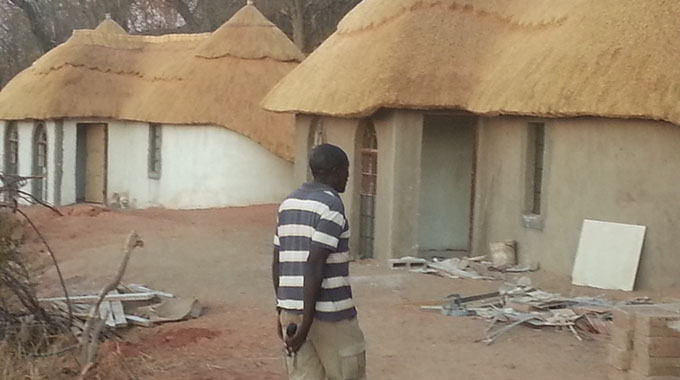Defe Dopota: A citadel of religion

Freedom Mupanedemo Features Writer
The Zimbabwe Christian Church (ZCC)’s Defe-Dopota Shrine in Gokwe has come of age.
As one arrives on the verges of the shrine, everything changes. The air itself is becomes eerie and profound. The atmosphere exudes holiness. Myth and mystery takes offer. Hair rises and stands up on its roots in mystical ovation.
Just like Vatican City’s St Peter’s Basilica which houses the tomb of the first Pope, leader of the Catholic Church since the year 1378, and attracts over 15 million visitors annually, or the iconic Kashi Temple of Hinduism in India, Defe Dopota Shrine in Gokwe is Zimbabwe’s citadel of religious tourism – a conduit for pilgrims.
Founded by the late Samuel Mutendi back in 1925 – a man born pre-maturely but defied all odds and survived when village soothsayers could not approve this type of “cursed” birth – Defe Dopota has over the years, seen Zion pilgrims from across Africa and beyond converging on an annual basis to commemorate “Zuva raSamuel” (The day of Samuel).
Born Mutendeziso, from which the surname Mutendi was derived, Samuel’s birth and survival has remained a mystery and awe inspiring up to this day.
Back then, the community wisdom were the communal elders with grey beard, whose word was regarded as the only authentic opinion of society and therefore final.
Their consciousness of the natural world had it that the Biblical Adam was created alone, not because God had run out of material but that he meant it to be that way.
Then came Eve, Adam’s helper and the two subsequently produced two sons, Cain and Abel in the same enjoin not in one month, five months or seven months but a protracted nine months. According to the local legend, anything outside this arrangement was a curse and an abomination.
Such births were regarded as an expression of anger by the gods.
Practically a premature baby or twins were to be left by the banks of the river and the river gods (njuzu/mermaids) would accept it as a perfect appeasement.
In the early hours of dawn drums would be heard where the baby would have been left signifying the acceptance of the offering.
So, after delivering Samuel prematurely in the dead of the night and realising that it was an abomination that would attract the ire of the ancestors of the land, the ZCC manuscripts have it that the mother, Shehu and one Mbuya Makuwa dumped him in a goats’ pen in the hope that by sunrise the following day he would have been devoured by predators.
The silence of the night, the shining stars and apparently the cool zephyrs, which under normal circumstances would have hastened the demise of this presumed curse ironically made a perfect combination to allow him to survive up to dawn.
It was only after the grandmother woke up early in the morning to surreptitiously take him to the place of the dead and escape the wrath of village elders that she was shocked to find the infant breathing and in fact, blinking.
This, the ZCC records, marked the beginning of the story of a man whose survival was laced with awe and mysticism.
He grew to be a famous man of God whose existence would be marked by numerous tribulations.
The story of his birth and rise to stardom is an interesting one and sounds more of a fairy tale than reality but this is what the Zionists that gather once every year in Defe believe and will be commemorating in unison.
In 1913, Mutendi is said to have been baptised by the Holy Spirit while working as a policeman under the British South African Police in Hartley, now Chegutu. He was reportedly later to be expelled from the force over his innumerable Pentecostal seizures during which he would speak in tongues.
He was to later trek down to South Africa at the invitation of one Engenas Lekganyane and their collaboration saw the birth of the Zion Christian Church in 1925.
Unlike today’s preachers who in independent Zimbabwe, Samuel pursued his vision in a very hostile and brutal environment. He was arrested several times and later condemned to places such as Gokwe and Defe that were considered inhabitable at the time in the hope that he would be killed by wild animals.
But he survived.
On July 20, 1976 it is recorded that this “great man” passed on and it is reported that God revealed his glory by showing his portrait on a star in the night sky – Nyeredzi yaSamere on July 23, 1976.
This marked the end of an era of the great man.
Samuel was buried at Defe in Dopota and thus members of his church flock every year to commemorate his lifetime achievements.
His successor, Bishop Nehemiah Mutendi has even pulled-up the tide and is working on turning the shrine into a modern religious tourist attraction, a development which has even attracted the interest of the Government.
Recently, Environment, Climate, Tourism and Hospitality Minister, Mangaliso Ndlovu together with a Government delegation toured Defe Dopota ZCC shrine where some of these awe-inspiring stories about this religious sanctity were told.
Bishop Mutendi, who has turned the shrine into a mini-town, said he intends to add to the shrine’s lustre by turning it into a sanctuary as well.
He, however, pleaded for Government support for the upgrading of the shrine, which he says attracts over 50 000 pilgrims per year, to be a fully-fledged tourist attraction with a sanctuary.
“People come from various places to grace this shrine. Some fly into the country and drive to the place.
“We therefore appeal for Government support so that we upgrade the roads and develop this shrine to be of a global religious status,” said Bishop Mutendi.
With elegant mansions built haphazardly around the shine and more linear houses and lodges stretching for a distance exceeding 2km under construction around the shrine, Bishop Mutendi says the shrine will take advantage of the nearby game park for it to be a sanctuary.
Minister Ndlovu said his ministry will work hand in hand with the Home Affairs Ministry to complement work that has already been done at the shrine towards tuning it into a world class religious tourist attraction.
“What is interesting is that this is a community-driven project. We are coming in as Government to complement what the church and the community have already done.
“We will work together to market this place and make it meet world standards,” he said.
For the pilgrims, a walk in the shrine is somewhat a soothing experience.
At the shrine, a huge open structure — the Zion pilgrims’ temple — is the first imposing super structure that meets the eye.
Rev Samuel’s grave is seated on a one-hectare brick-walled piece of land with mansions said to belong to his successor, Nehemiah’s four wives circling the grave.
The shrine is guarded 24 hours.
Only a few people are allowed inside the shrine but not before a long “consulting” prayer is conducted by Bishop Mutendi himself.
The Defe Dopota area might be viewed by most locals as one of the remotest and underdeveloped areas in the country. Nature and geomorphology have combined to exhibit an exhausted and ugly side of the area, but the ZCC church is slowly turning the place into a breathtaking religious shrine.
Chief Nemangwe, who shares a border with Defe Dopota, does not see the tourism side of Defe Dopota shrine. He says the ZCC church has turned the place, long regarded as a dry serpent of acacia woodland, into an oasis of hope with many opportunities.
“There has been a lot of construction taking place in Defe Dopota and people are going there seeking employment. In the near future we’re confident that Defe will be a fully-fledged town employing many of our people,” he said.










Comments